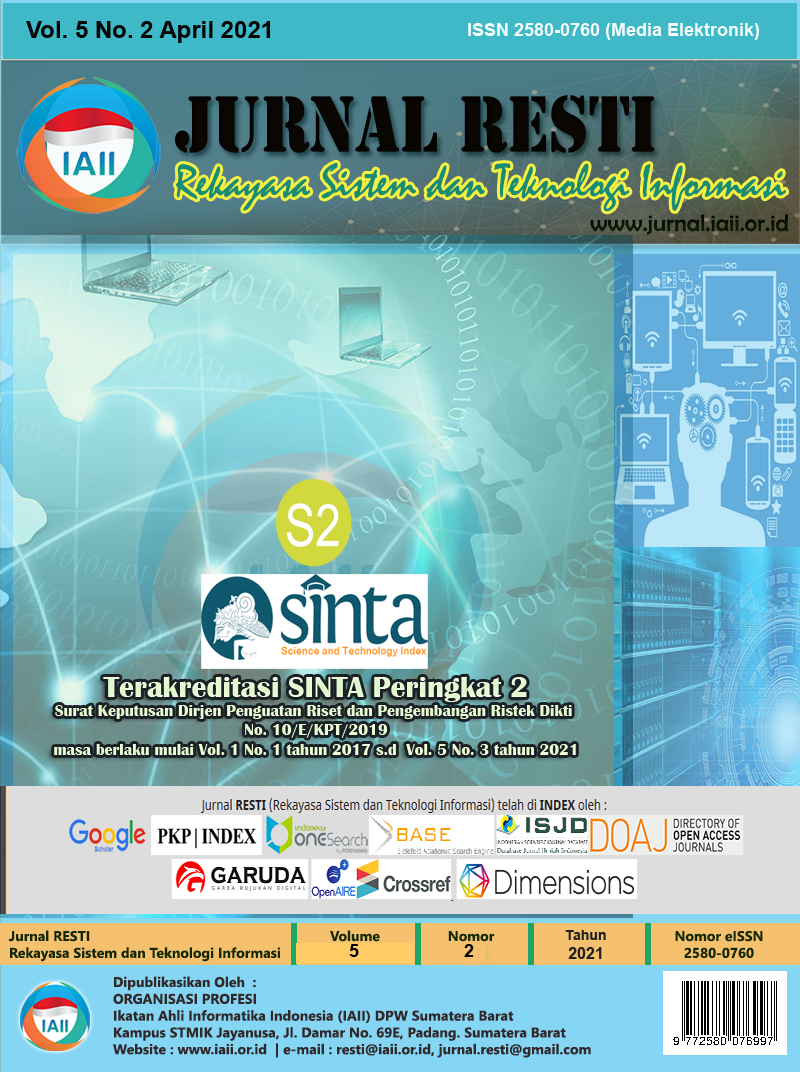Optimasi Business Process Improvement Berbantuan Metode FLASH dengan Integrasi API Trello
Abstract
The emergence of the COVID-19 case has a major impact on all sectors. At this critical time, customer satisfaction can be done by optimizing the use of resources by implementing BPI. The BPI method will conduct a review regarding the resources owned and will be adjusted to the current conditions. BPI is closely related to changes in project management. One of the optimal methods used in project management is FLASH, where the project duration will be in the form of a more flexible time interval. In this research, the system also uses Trello as a project management application. The purpose of this research is to design a scheme for calculating the duration of the project, as well as mapping project management from the data tasks that are owned using the FLASH method. System testing on the fuzzy system algorithm is implemented on the AOA network. Based on the calculation on the test object carried out, the probability of completing the project on time is 76%. This amount is obtained from the average delay factor for each task. With these values, scheduling using the FLASH method obtained the fastest duration is 19 days and the latest is 30 days.
Downloads
References
E. G. Too and P. Weaver, “The management of project management: A conceptual framework for project governance,” Int. J. Proj. Manag., vol. 32, no. 8, pp. 1382–1394, 2014, doi: 10.1016/j.ijproman.2013.07.006.
D. Of, T. H. E. European, and F. O. R. Reconstruction, “Strategy implementation plan 2019 - 2021,” 2021.
E. S. Ahmed, M. N. Ahmad, and S. H. Othman, “Business process improvement methods in healthcare: a comparative study,” Int. J. Health Care Qual. Assur., vol. 32, no. 5, pp. 887–908, 2019, doi: 10.1108/IJHCQA-07-2017-0116.
T. Joseph, “Business Process Re-engineering: Facing Crisis with Confidence,” Fingent, 2020. https://www.fingent.com/blog/business-process-re-engineering-facing-crisis-with-confidence/.
C. Maciel, R. Neder, P. Ramalho, O. Rabelo, E. Zambra, and N. Benevides, “Business Process Management: Terms, Trends and Models,” Commun. Pap. 2018 Fed. Conf. Comput. Sci. Inf. Syst., vol. 17, pp. 163–170, 2018, doi: 10.15439/2018f334.
F. Habibi, O. Taghipour Birgani, H. Koppelaar, and S. Radenović, “Using fuzzy logic to improve the project time and cost estimation based on Project Evaluation and Review Technique (PERT),” J. Proj. Manag., vol. 3, pp. 183–196, 2018, doi: 10.5267/j.jpm.2018.4.002.
A. Aliyu, “Project Management using Critical Path Method (CPM): A Pragmatic Study,” Glob. J. Pure Appl. Sci., vol. 18, no. 3–4, 2013, doi: 10.4314/gjpas.v18i3-4.11.
F. H. Lermen, M. de F. Morais, C. Matos, R. Röder, and C. Röder, “Optimization of Times and Costs of Project of Horizontal Laminator Production Using Pert/Cpm Technical,” Indep. J. Manag. Prod., vol. 7, no. 3, pp. 833–853, 2016, doi: 10.14807/ijmp.v7i3.423.
Suratno, “Pengaruh Perbedaan Tipe Fungsi Keanggotaan Pada Pengendali Logika Fuzzy Terhadap Tanggapan Waktu Sistem Orde Dua Secara Umum,” pp. 1–10, 2002.
A. Sooraj and A. Paul, “Fuzzy Logic in Construction Project Scheduling: a Review,” Int. Res. J. Eng. Technol., vol. 05, no. 11, pp. 752–755, 2008, [Online]. Available: www.irjet.net.
Muliani, “Perbandingan Optimalisasi Waktu dengan Metode Program Evaluation and Review Technique dan Fuzzy Logic Application for Scheduling pada Penjadwalan Proyek,” 2019.
R. Dubey and S. S. Ali, “Identification of flexible manufacturing system dimensions and their interrelationship using total interpretive structural modelling and fuzzy MICMAC analysis,” Glob. J. Flex. Syst. Manag., vol. 15, no. 2, pp. 131–143, 2014, doi: 10.1007/s40171-014-0058-9.
Castro-Lacouture, “Construction project scheduling with time, cost, and material restrictions using fuzzy mathematical models and critical path method,” J. Constr. Eng. Manag., vol. 135, no. 10, pp. 1096–1104, 2009, doi: 10.1061/(ASCE)0733-9364(2009)135:10(1096).
A. Primanita and F. Muliawan, “Fuzzy Logic Implementation on Enemy Speed Control to Raise Player Engagement,” pp. 119–123, 2014.
L. S. R. Supriadi, Y. Latief, B. Susilo, and M. Rajasa, “Development of risk-based standardized WBS (Work Breakdown Structure) for cost estimation of apartment’s project,” Int. J. Civ. Eng. Technol., vol. 8, no. 10, pp. 822–833, 2017.
P. Janál and T. Kozel, “Fuzzy Logic Based Flash Flood Forecast,” no. November, 2020, doi: 10.15407/uhmi.conference.01.10.
L. I. Cioca, R. E. Breaz, and G. S. Racz, “Fuzzy Logic Techniques used in Manufacturing Processes Reengineering,” Proc. 6th WSEAS Int. Conf. Simulation, Model. Optim., no. September, pp. 22–24, 2006.
R. Rekik and I. Kallel, “Fuzz-Web: A Methodology Based on Fuzzy Logic for Assessing Web Sites,” Int. J. Comput. Inf. Syst. Ind. Manag. Appl., vol. 5, no. April, pp. 126–136, 2013.
D. P. C. C. L. E. Y. N. to K. in 20 Weeks, “Optimalisasi Waktu dengan Metode Program Evaluation and Review Technique dan Fuzzy Logic Application for Scheduling pada Penjadwalan Proyek,” Dk, vol. 53, no. 9, pp. 1689–1699, 2015, doi: 10.1017/CBO9781107415324.004.
I. Fahrurrozi and A. SN, “Buku Pintar Framework Yii,” J. Online STMIK, vol. 1, no. 2012, p. 120, 2015, [Online]. Available: mediakom-penerbit.com.
O. A. Rashid and M. N. Ahmad, “Business Process Improvement Methodologies : An Overview,” J. Inf. Syst. Res. Innov., vol. 5, pp. 45–53, 2013, [Online]. Available: http://seminar.utmspace.edu.my/jisri/.
N. Vizkia, S. Sugiono, and C. F. Mada Tantrika, “Perbandingan Metode Pert Dan Fuzzy Logic Application For Schedulling (Flash) Pada Penjadwalan Proses Fabrikasi Boiler (Studi Kasus: PT Indonesian Marine Corp. Ltd.),” J. Rekayasa dan Manaj. Sist. Ind., vol. 2, no. 3, pp. p482-494, 2014.
M. H. Hamzah and S. El Unas, “Penjadwalan Proyek Konstruksi Dengan Metode Flash ( Fuzzy Logic Application for Scheduling ),” 2019.
Copyright (c) 2021 Jurnal RESTI (Rekayasa Sistem dan Teknologi Informasi)

This work is licensed under a Creative Commons Attribution 4.0 International License.
Copyright in each article belongs to the author
- The author acknowledges that the RESTI Journal (System Engineering and Information Technology) is the first publisher to publish with a license Creative Commons Attribution 4.0 International License.
- Authors can enter writing separately, arrange the non-exclusive distribution of manuscripts that have been published in this journal into other versions (eg sent to the author's institutional repository, publication in a book, etc.), by acknowledging that the manuscript has been published for the first time in the RESTI (Rekayasa Sistem dan Teknologi Informasi) journal ;








